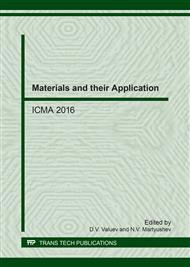p.3
p.8
p.12
p.18
p.23
p.29
p.35
p.40
Experimental Research of Crack Resistance of Composite Materials
Abstract:
An adhesive composition is used as a binder in many composite materials. Crack resistance of an adhesive composition is the most important characteristic determining the bearing capacity of composite materials. To date, a significant number of methodological recommendations and standards have been developed for estimation of adhesive compositions bearing capacity in different types of loading forces exertions which, with certain assumptions, can be used to assess their crack resistance. Known testing procedure for crack resistance of adhesive composition was selected as a basic one. It includes a bending load in the form of loadings acting perpendicular to cantilever beams which is applied to the double-cantilever sample. Therewith a sample response and a corresponding change in length of the resulting crack in the adhesive compound layer are being recorded. This is followed by a determination of the specific energy of crack propagation which provides information about the value of crack resistance.
Info:
Periodical:
Pages:
8-11
Citation:
Online since:
June 2017
Authors:
Keywords:
Price:
Сopyright:
© 2017 Trans Tech Publications Ltd. All Rights Reserved
Share:
Citation:


